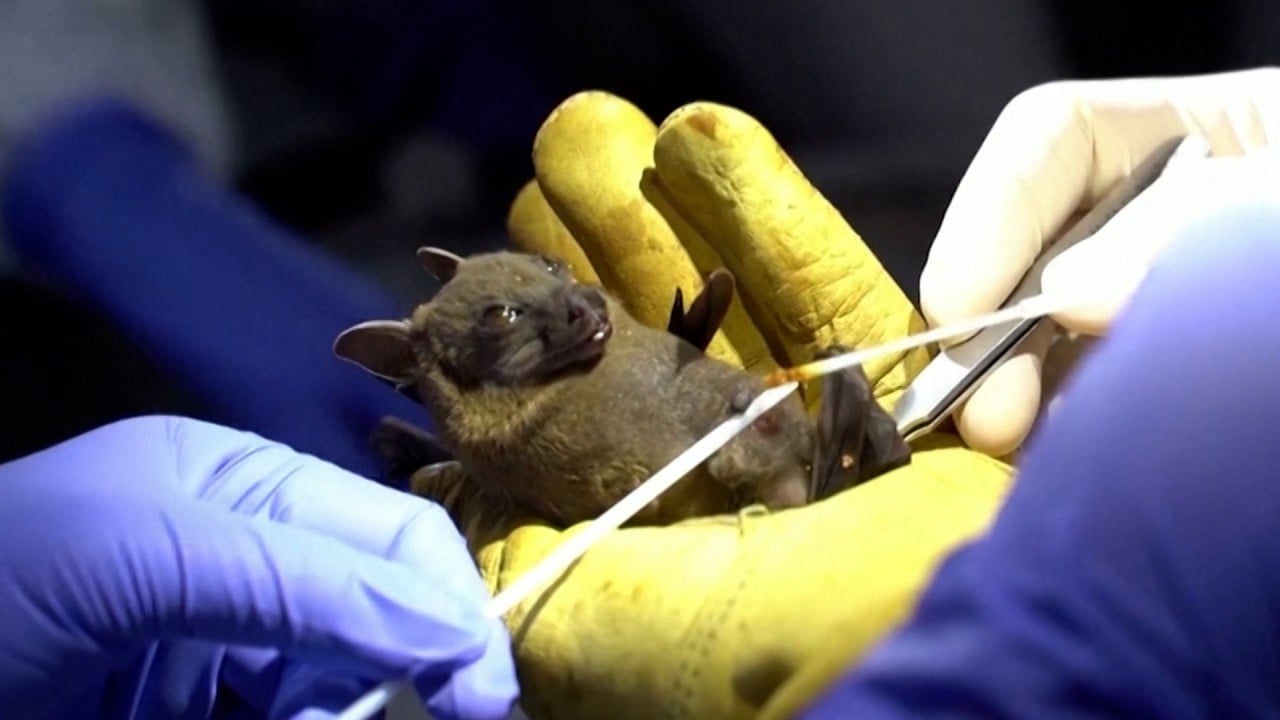
Do bats carry deadly viruses? Yes. Would a cull help? No. Here’s why
- Virus spillover events more often than not result from human activities causing habitat loss, researchers note
- Bats are also key components of intricate ecological networks and their destruction would upset that balance
One summer afternoon in 2020, Beijing resident Chen Daming spotted a bat outside his flat. It seemed to be flying round and round the hallway, looking for a way to get out.
“I had to make three calls before anyone showed up and they bashed the bat dead with a dustpan just at my door. The creature squeaked at each bang and there was blood. I can’t forget the messiness,” Chen recalled.
Bats were once considered a sign of good fortune in Chinese culture, as their name sounded like the word for blessing. However, the animals have in modern times been shunned or even killed for fear they might bring disease.
More than 200 viruses from almost all viral families have been isolated in bats, suggesting they might harbour a substantial diversity of viruses that are zoonotic, or capable of being transmitted from animals to humans. These include potentially deadly pathogens like the rabies, Nipah and Ebola viruses. However, these are thought to need an intermediate animal host to be transmitted to humans.
Scientists worry that unfounded fears about virus origins could lead to the culling of bats -which will not eliminate disease but will surely damage the ecological system.
This came as a precautionary measure, in the belief that the Sars virus in humans came via civet cats. It was only in 2013 that a team of international scientists isolated a very close relative of the Sars virus from horseshoe bats in China, confirming the species as its origin.
The culling of vampire bats, known to carry the rabies virus which causes thousands of livestock deaths annually, and occasionally a few human fatalities, has been practised for decades in some Latin American countries.
But the culling of bats will not reduce disease transmission, warn scientists. That is because spillover events – when pathogens jump from animals to humans – are more likely to be the result of human activities that facilitate such opportunities.
Instead of a mass cull, therefore, bats needed to be studied to better understand such spillover events, and conserved to continue their important role in the ecologic system, they say.
“The probability of catching a disease from a bat is low, and there is only really a risk if you are either bitten or if someone consumes them,” said Alice Hughes, an associate professor with the University of Hong Kong whose research focuses on conservation and bats.
“While bats are great at hosting various zoonoses, spillover events are still very rare, so even as a bat researcher most precautions I take when I handle bats are only to avoid being bitten,” she said.
Spillover events thought to have sparked other coronavirus outbreaks include Sars and Middle East Respiratory Syndrome (Mers) in 2012. Also, a kind of fruit bat is thought to be a natural host for the Ebola virus, first identified in 1976 and causing an often-fatal haemorrhagic fever. Ebola killed at least 11,300 people in West Africa in a 2014-2016 epidemic.
Coronaviruses genetically similar to Sars-CoV-2 have been identified within bat populations in caves in North Laos and in Yunnan province in southwestern China.
Susan Tsang, a research associate with the American Museum of Natural History in New York, said potential spillovers of harmful pathogens from wildlife to humans largely occurred due to heightened levels of human disturbance, and scientists needed to have a clearer understanding of why these events were happening with greater frequency.
“Many natural reservoir hosts, including bats, have been negatively impacted by disturbance of natural ecosystems by human activity – that can vary anywhere from clearing land for urban settlements to mining in caves, and some of these hosts have also been directly exploited by humans, such as the wildlife trade,” Tsang said.
Citing empirical support that shows that these types of disturbances are more powerful in determining where spillover potential exists, Tsang said it was not inherently necessary that bats must be feared as natural host reservoirs for viruses.
“When you have stressed wild animals that cannot be in good health due to the degraded environment around them, and they are now potentially coming into contact with humans or other potential intermediary hosts more often than they should as in the wildlife trade, you are creating situations where that zoonotic spillover is possible when it should not have been in normal, natural conditions,” Tsang explained.
Bats come in 1,400 species, making up over 20 per cent of all classified mammals. The fact that bats exist in such large numbers of species might be a factor in why so many pathogens that infect humans can be traced back to them, according to a 2020 paper from the Medical Research Council-University of Glasgow Centre for Virus Research.
Scientists maintain that it is important to continue to research bats, to help humans prepare for possible future spillover events that may introduce a new disease.
“As human numbers increase and people encroach deeper into remaining natural habitats, human-bat interactions are becoming more frequent, with often undesirable consequences to both humans and bats,” said Ricardo Rocha, conservation ecologist and researcher at the University of Porto, Portugal.
“Continuous surveillance is thus of paramount importance for the prevention of future zoonotic outbreaks. In particular, we need to identify potential drivers of bat-associated zoonotic spillover events and we equally need to investigate the risk of pathogen transmission to bats from humans or other species.”
But killing bats was a cause for concern, Rocha said, as past experience had shown that actions such as culling not only failed to eliminate disease risks but could also increase the risk of zoonotic disease spreading to humans.
A study in 2012 of 20 colonies of common vampire bats in Central and South America found that killing them not only failed to eliminate rabies in disturbed colonies but inadvertently led to an increase in the proportion of infected bats compared to undisturbed ones, Rocha said. Moreover, bites from infected dogs were responsible for over 99 per cent of rabies-related deaths.
Bats are also key components of intricate ecological networks and have long been identified as important service providers for humans, according to Rocha.
They preyed on agricultural pests, consumed important disease vectors such as malaria-bearing mosquitos, and pollinated culturally and economically important fruit crops such as durian, agave and dragon fruit, he said.
“The disappearance of bats can lead to enormous economic losses. The economic value of bats to North American agriculture alone has been estimated at around US$23 billion per year and probable wide-scale ecosystem collapse.”
Removing a local bat population might introduce gaps in the local environment – which would then be filled by other bats from elsewhere, argues Tsang at the American Museum of Natural History. These incoming bat species may host different strains of a similar pathogen, including potentially more virulent ones, which can then spread in a new location, she warns.
It is humans that are increasingly disturbing bats’ natural habitats, not the other way round
Some bat species have in fact become vulnerable or endangered because of loss or fragmentation of habitats, diminished food supply, diseases or hunting and culling of bats.
“It is humans that are increasingly disturbing bats’ natural habitats, not the other way round,” said Yang Xiaohong, director of research with the China Biodiversity Conservation and Green Development Foundation.
“The growing population and expanding economic activities have reduced their space to live, which means we humans have more chance to interact with bats and more chances for pathogens to jump from bats.
“For our own good, we should leave them some space.”
Habitat loss from urbanisation can lead to bats living in suboptimal roosting sites, such as old buildings, which can expose them to more predators such as cats, and risk more human exposure to bats as well, Tsang said.
“Instead of having bats live in these buildings, encourage the placement of bat houses either on the side of the building or in parks or green spaces,” she suggested.
Hughes at HKU said as bats need intact roosting sites, better policies needed to be drafted so as to not disturb caves or even lofts, especially during the critical breeding or hibernation seasons when they are already stressed.
“Basically if you leave the bats alone they will leave on their own, and they will try to avoid people, like most small animals they are scared of humans and will try to avoid them,” Hughes said.
“If we … coexist better with other species, they are less likely to spread diseases, both because they are less likely to encounter other animals and are likely to spillover less of anything they might carry.”




